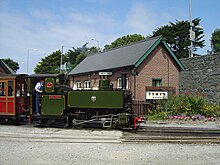L. T. C. Rolt
Lionel Thomas Caswall Rolt (usually abbreviated to Tom Rolt or L.T.C. Rolt) (11 February 1910–9 May 1974; his death was recorded in The Times No 59086, 11 May 1974) was a prolific English writer and the biographer of major civil engineering figures including Isambard Kingdom Brunel and Thomas Telford. He is also regarded as one of the pioneers of the leisure cruising industry on Britain's inland waterways, and as an enthusiast for both vintage cars and heritage railways.
Biography
Born in Chester, Rolt studied at Cheltenham College and then trained as a mechanical engineer, before taking up an engineering post at the Kerr Stuart locomotive works in Stoke-on-Trent.
He was Vice-President of the Newcomen Society, a member of the Science Museum Advisory Council and of the York Railway Museum Committee; an honorary MA of Newcastle, an honorary MSc of Bath and a Fellow of the Royal Society of Literature.
Rolt produced many works about subjects which had not previously been considered the stuff of literature: civil engineering, canals, railways, etc. His first book, Narrow Boat, was an account of his and his first wife Angela's honeymoon journey around the canal system of the English Midlands aboard a 70ft long wooden narrowboat named Cressy.
He spent 12 years living afloat. He was a co-founder and the first honorary secretary of the Inland Waterways Association. A bridge on the Oxford Canal in Banbury bears his name, as does a centre at the boat museum at Ellesmere Port in Cheshire. From the 1950s to his death in 1974, Rolt lived in the Gloucestershire hamlet of Stanley Pontlarge.
He was also a founder member of the Vintage Sports-Car Club.

During the early 1950s, Rolt was general manager of the Talyllyn Railway — he co-founded the Talyllyn Railway Preservation Society, the world's first preserved railway — near Tywyn in Mid Wales, where a locomotive 'Tom Rolt' was later (1991) named in his memory. His book Railway Adventure recalls this period.
Rolt observed the changes in society due to the industrial-scientific revolution. In the epilogue to his biography of I.K.Brunel he writes two years before C. P. Snow makes similar statements about the split between the arts and sciences:
Men spoke in one breath of the arts and sciences and to the man of intelligence and culture it seemed essential that he should keep himself abreast of developments in both spheres. ... So long as the artist or the man of culture had been able to advance shoulder to shoulder with engineer and scientist and with them see the picture whole, he could share their sense of mastery and confidence and believe wholeheartedly in material progress. But so soon as science and the arts became divorced, so soon as they ceased to speak a common language, confidence vanished and doubts and fears came crowding in.
He set out these ideas more fully in his book High Horse Riderless, a classic of green philosophy. Rolt was the subject of a biography (Tom Rolt and the Cressy Years) by Ian Mackersey in 1985, and a bibliography by Ian Rogerson in 1994.[1]
Bibliography
Rolt's work (arranged by topic) included:
Waterways
- Narrow boat (1944)
- Green and silver (1949)
- The inland waterways of England (1950)
- The Thames from mouth to source (1951)
- From sea to sea: the Canal du Midi (1973)
- Navigable Waterways. (1973) London: Hutchinson. ISBN 0-0990-7800-7
Railways
- Lines of character (1952)
- Railway adventure (1953)
- Rolt, L. T. C. Red for Danger.
- Patrick Stirling's locomotives (1964)
- The making of a railway (1971)
Motoring
- Horseless carriage: the motor car in England (1950)
Industrial History
From the period of 1958 onwards, Rolt was commissioned by many engineering companies to document their history. Many of these are unpublished internal documents; only the published works are listed here.
- The Dowty story (part I 1962, part II 1973)
- A Hunslet Hundred: one hundred years of locomotive building by the Hunslet Engine Company (1964)
- Tools for the job: a history of machine tools (1965)
- The Mechanicals: progress of a profession (1967)
- Thomas Newcomen: The prehistory of the steam engine (1968)
- Waterloo Ironworks: a history of Taskers of Andover, 1809–1968 (1969)
- Victorian engineering (1970)
- The potters' field: a history of the South Devon ball clay industry (1974)
Biography
- Isambard Kingdom Brunel: a biography (1957)
- Thomas Telford (1958)
- The Cornish giant: the story of Richard Trevithick, father of the steam locomotive (1960)
- George and Robert Stephenson: the railway revolution (1960)
- Great Engineers (1962)
- James Watt (1962)
Other works
- High horse riderless (1947)
- Worcestershire (1949)
- Winterstoke (1954) — the history of a fictional Midlands town
- The clouded mirror (1955)
- The Aeronauts: A History of Ballooning 1783-1903 (1966), republished as The Balloonists: The History of the First Aeronauts (2006)
- Landscape with Machines (1971) London: Longman. ISBN 0-5821-0740-7 — the first part of his autobiography)
- Landscape with Canals (1977 — the second part of his autobiography)
- Landscape with Figures (1992 — the retitled third part of his autobiography)
The Landscape Trilogy (2001) combines all three parts of his autobiography in one volume.
He also wrote ghost stories and two collections of his work were published:
- Sleep No More (1948)
- Two Ghost Stories (1994)
References
- ^ Rogerson, Ian (1994). L.T.C. Rolt: a bibliography. M & M Baldwin. ISBN 0-947712-04-6.
